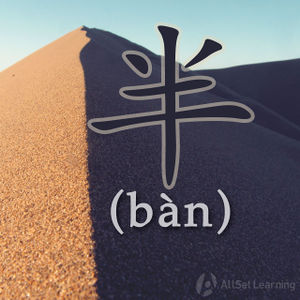Difference between revisions of "Expressing "half" with "ban""
m (Text replacement - "xīngqí" to "xīngqī") |
|||
| Line 56: | Line 56: | ||
* 七 <strong>瓶</strong> <em>半</em> 酒 <span class="pinyin">qī <strong>píng</strong> <em>bàn</em> jiǔ</span><span class="trans">seven and a half bottles of liquor</span> | * 七 <strong>瓶</strong> <em>半</em> 酒 <span class="pinyin">qī <strong>píng</strong> <em>bàn</em> jiǔ</span><span class="trans">seven and a half bottles of liquor</span> | ||
* 八 <strong>只</strong> <em>半</em> 鸡 <span class="pinyin">bā <strong>zhǐ</strong> <em>bàn</em> jī</span><span class="trans">eight and a half chickens</span> | * 八 <strong>只</strong> <em>半</em> 鸡 <span class="pinyin">bā <strong>zhǐ</strong> <em>bàn</em> jī</span><span class="trans">eight and a half chickens</span> | ||
| − | * 九 <strong>个</strong> <em>半</em> 星期 <span class="pinyin">jiǔ <strong>gè</strong> <em>bàn</em> | + | * 九 <strong>个</strong> <em>半</em> 星期 <span class="pinyin">jiǔ <strong>gè</strong> <em>bàn</em> xīngqī</span><span class="trans">nine and a half pieces of meat</span> |
* 十 <strong>包</strong> <em>半</em> 饼干 <span class="pinyin">shí <strong>bāo</strong> <em>bàn</em> bǐnggān</span><span class="trans">ten and a half bags of crackers</span> | * 十 <strong>包</strong> <em>半</em> 饼干 <span class="pinyin">shí <strong>bāo</strong> <em>bàn</em> bǐnggān</span><span class="trans">ten and a half bags of crackers</span> | ||
Revision as of 17:40, 2 January 2015
半 (bàn) means "half." That's simple enough, but what can get slightly tricky is the rules for how it combines with measure words. We explain all those here.
Contents
Standard Usage
Used alone
Structure
半 + Measure Word + Noun
Examples
The measure words are also indicated below.
- 半 个 小时 half an hour
- 半 个 月 half a month
- 半 个 苹果 half an apple
- 半 碗 米饭 half a bowl of rice
- 半 条 鱼 half a fish
- 半 只 鸡 half a chicken
- 半 杯 红酒 half a glass of red wine
- 半 瓶 酒 half a bottle of liquor
- 半 份 炒面
- 半 块 巧克力
With a Number
When it's more than just a half, then 半 (bàn) comes after the measure word instead of before. It's the difference between "half an hour" and "an hour and a half." The order is actually basically the same as what we do in English (we just don't have so many pesky measure words to keep track of in English!).
Structure
Number + Measure Word + 半 + Noun
Examples
- 一 个 半 小时 an hour and a half
- 两 个 半 月 two and a half months
- 三 个 半 苹果 three and a half apples
- 四 杯 半 红酒 four and a half glasses of red wine
- 五 碗 半 米饭 five and a half bowls of rice
- 六 条 半 鱼 six and a half fish
- 七 瓶 半 酒 seven and a half bottles of liquor
- 八 只 半 鸡 eight and a half chickens
- 九 个 半 星期 nine and a half pieces of meat
- 十 包 半 饼干 ten and a half bags of crackers
Notable Exceptions
There are some words that act as their own measure words, notably the time words 天 (tiān), meaning "day," and 年 (nián), meaning "year."
Used alone
Structure
半 + 天/年
Examples
- 半 天 half a day
- 半 年half a year
Note that you do not need to use 个 (ge) here; in fact, it's wrong to do so:
- 半 个 天 half a day
- 半 个 年 half a year
With a Number
Structure
Number + 天/年 + 半
Examples
- 两 天 半 two and a half days
- 一 年 半 a year and a half
- 三 天 半 three and a half days
- 四 年 半 four and a half years



